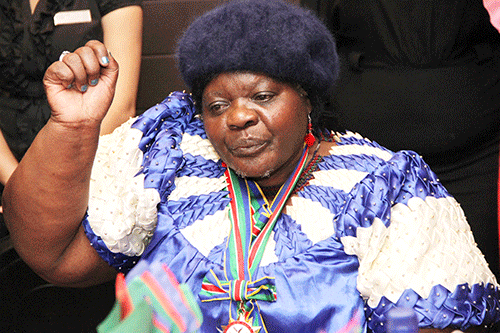As we mourn a veteran of the Namibian liberation struggle Ida Jimmy !Ha-Eiros, who died on 3 April this year, I reflect on our days at Gobabis in 1979.
I met this imposing figure at the female section of the Gobabis prison on that fateful night in May 1979. Ida was compelled by circumstances to bring her nine-month-old baby, Natangwe Jimmy, along to prison. She felt that it was safer to keep him with her in prison than to entrust her small boy to someone else. Gobabis prison did not have baby food or formula milk for infants. Thus, Michael, or Natangwe - as she fondly called him, ate the same food we ate: brown bread and coffee in the morning, and in the evening for lunch we had samp (stamp mielies). This diet did not change for the full five months that we were detained at Gobabis.
Ida and myself were each held in a tiny cell, approximately one metre by two-and-a-half metres, with a small wndow facing a long corridor on the inside of the western side and a concrete wall on the outside, which also served as a wall fence of this huge prison. This prison was massive or colossal for a small town the size of Gobabis. At that time, 136 Swapo leaders, activists and unionists were detained at this penitentiary, and Ida and I were the only women, and separated from the rest at the female section, and of course, little Natangwe.
The countrywide detentions were intended to crack down on Swapo, which was growing in popularity due to the then talks of a UN supervised election under Resolution 435 of the Security Council. Earlier on, South Africa had attempted to wriggle itself out of fulfilment of this resolution by attacking Cassinga.
The detentions were carried out under a draconian law called AG26. AG stood for “Administrator General”, a senior representative of the South African colonial regime in Namibia. It provided for detention without trial and without legal representation. It further provided for solitary confinement, and incommunicado, which meant that we were not allowed to receive visitors or to speak to anyone, or to read newspapers and so forth.
Officially, comrade Ida and I were allowed out of our tiny cells, into the aforesaid immediate corridor, for 30 minutes in the evening. During this short interval, we were exchanging newspapers, which were smuggled into prison by black prison warders who were hiding them in a plastic bag placed at the bottom of our samp. So, our plates always looked full of “stamp miellies”, but were actually filled with newspapers underneath the samp. These newspapers kept us informed about current affairs in Namibia and elsewhere.
Whenever we asked the prison wardens what we had done to be detained, they would say, “go and ask the administrator general, we don’t know.”
The truth is that the ruthless repression of Swapo supporters and sympathisers was meant to intimidate and thwart popular rebellion, and we were being oppressed because we revolted against foreign occupation, inferior Bantu education, racial discrimination and the appropriation of arable land for white settler farmers, and most importantly, we were against the exploitation of the country’s mineral and other resources. Swapo morale during these days was boosted by the prospects of United Nations' supervised elections, and the majority of the Namibian people were yearning for freedom, and to be treated equally and fairly.
What comrade Ida Jimmy taught me was not to fear anything under any circumstance. She would tell me about her senior sister who pre-deceased her and her fight against racism in Lüderitz. This fearlessness was demonstrated in Ida Jimmy’s call on Namibians to “offer assistance to Plan freedom fighters”- specifically water and food – which came from her heart. For this reason, the fascist regime sentenced her to imprisonment under AG9, another authoritarian law which provided for arrest and imprisonment unsupported by any criminal act or omission. A mere utterance of public support for the armed liberation struggle was sufficient to warrant prosecution and jail. Under these political charges, like the Nazis, to the South Africans, the moment you enter the dock, your guilt was already cast in stone.
Like Ida, I had also been detained under the Terrorism Act of 1967. I was suspected of furthering the aims of a “terrorist” organisation. A security policeman by the name of Botha came to my parents’ house in December 1978, quoting Section 3 of the Terrorism Act No 83 of 1967.
He said, “I think you know it better than others.” It was not because at that time I was Swapo secretary for legal affairs in the country, but because the Plan fighters had just detonated bombs at the Odean Cinema Hall and at the Nictus Building in Windhoek that Saturday. That fateful day, Swapo members and supporters had staged a peaceful demonstration in front of the main post office on Independence Avenue, then Kaiser Street.
Comrade Ida was also detained and incarcerated under the Terrorism Act. It is worth noting that this is the same draconian law under which comrade Andreas Nduuvu-Nangolo was executed and attempts made to send comrades Aaron Mushimba and Andreas Shikongo to the gallows in 1976.
In conclusion, comrade Ida Jimmy did all these acts of heroism not just for her freedom, but also for the country. Her commitment to the liberation struggle of her motherland was undaunted. The consequence was untold suffering and torture at the hands of the racist regime, which thousands of other Namibians endured under the vanguard of the liberation movement of Swapo. A true heroine in deed and in spirit. May her soul rest in eternal peace.
*Lucia Hamutenya was incarcerated with Ida Jimmy !Ha-Eiros at Gobabis in 1979.


